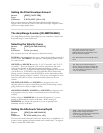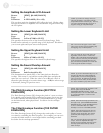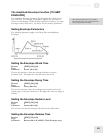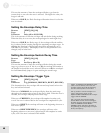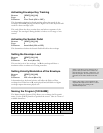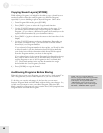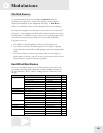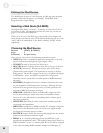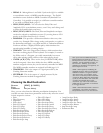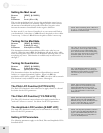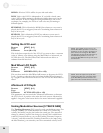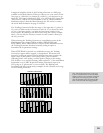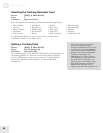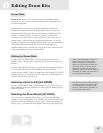
8
Modulations
50
Editing the Mod Routes
The Mod Routes are part of each Program, just like any other program
parameter (like Filter Frequency for example). Hit [EDIT] from
Program mode to begin editing.
Selecting a Mod Route [0-5 MOD]
In Program Edit Mode, use the [0] - [5] buttons to select one of the six
mod routes to edit. All modulators work in the same way, so only the
pages of one will be described here.
When you’re in one of the Mod pages, the top line of the display will
show whether that Mod is active. If the Mod is disabled (Level set to 00),
“mod” will be in small letters. If the Mod is enabled, “MOD” will be
capitalized.
Choosing the Mod Source
Buttons: [EDIT] [0-5 MOD]
Page: 1
Parameter: Src (see below)
Here, you can select one of the following modulation sources:
• NOTE # provides a modulation signal that corresponds to the note
played on the keyboard (higher keys give higher values).
• VELOCITY refers to how hard you hit the keys.
• REL VEL (Release Velocity) refers to how fast you let go of the keys.
• AFT TCH (Aftertouch) Pressing on the keys after they’re down
generates this control signal. This represents an average of all keys
being pressed. The harder you press on the keys, the greater the degree
of modulation. (Note, the QS8.2’s keyboard does not generate
aftertouch, but the synthesizer can still respond to MIDI aftertouch
messages).
• POLYPRES (Polyphonic Pressure) is similar to aftertouch, but each
key can respond to individual pressure messages. Although the QS’s
keyboard does not generate poly pressure, its sound generators can
respond to MIDI poly pressure messages.
• MOD WHL (Modulation Wheel) is traditionally assigned to LFO
level so that rotating the wheel away from you introduces vibrato.
However it is also well-suited for controlling timbre, vibrato speed,
and other parameters.
• PITCH WH (Pitch Wheel) usually controls the oscillator pitch but
can control other parameters.
• MIDI VOL corresponds to MIDI controller #7. Example: Assign the
filter cutoff as the destination, and you can have the signal become
less bright as it becomes lower in volume.
• SUST PED (Sustain Pedal) The sustain pedal plugged into the sustain
pedal jack provides this modulation signal.
• PEDAL 1: A controller pedal plugged into the [PEDAL 1] jack
provides this modulation source. The default setting assigns Pedal 1 to
MIDI Controller 7 to act as a volume pedal. But it can also be assigned
to any other incoming MIDI controller number in Global page 12.




